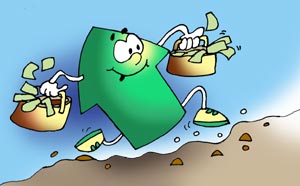|
|
| Help | |
| You are here: Rediff Home » India » Get Ahead » Money » Invest |
|
| |||||||||||||||||||||||
|
| |||||||||||||||||||||||

 he Sensex likes to climb uphill like those nursery rhyme characters, Jack and Jill. And then, just like them, it comes tumbling down (causing many heartbroken Jack and Jills to lose their wallets in the bargain).
he Sensex likes to climb uphill like those nursery rhyme characters, Jack and Jill. And then, just like them, it comes tumbling down (causing many heartbroken Jack and Jills to lose their wallets in the bargain).
Have you ever wondered what makes the Sensex move and who decides how it should move?
Undoubtedly, you have heard your share of eerie stories. Like the one about the mysterious unseen hand that moves the market. Or how the market has a mind of its own.
In reality, though, 30 stocks decide what the Sensex does.
In Sensex? What's that?, we explained what the Sensex is made of. Now, let's see what makes it move.
As you know, the Sensex comprises of 30 stocks. When the prices of these stocks increase, the Sensex goes up. When the prices decrease, the Sensex falls.
It sounds simple but it still does not answer the 'how' question.
Well, there is the market cap method
Each of the 30 stocks in the Sensex has a weight attached to it. This weight depends on the market capitalisation of the stock.
Market capitalisation refers to the number of shares of a company multiplied by its market value (the price of each share). For instance, if a company has 10 million shares whose value is Rs 30 per share on November 1, 2004, it will have a market cap of Rs 300 million on November 1, 2004.
If the market cap of the 30 Sensex stocks is Rs 3,00,000 crore and the market cap of ITC (which is one of the 30 shares that make up the Sensex) is Rs 20,000 crore, then ITC's weight in the Sensex is 6.66 percent.
The rise or fall in the price of ITC's shares will impact the Sensex to that extent.
This is referred to as the full market capitalisation methodology.
Now, let's check free-float weightage
The Sensex shifted to the free-float weightage method on September 1, 2003.
Here, a company's entire lot of shares are not taken into account (which means we are not looking at the entire market capitalisation). Only the shares readily available for trading are considered.
In every company, a certain amount of shares are not available for trading on the stock exchange. These shares could be held by the government or the promoters of the company. Under the free-float weightage method, they are not taken into account.
How does the stock exchange arrive at this weightage?
In this case, the market cap is multiplied by the free float factor (which is the proportion of a company's shares that can be readily bought and sold).
The Sensex's free float market cap at close of business on December 3 was Rs 3,66,124 crore.
Unlike the Sensex, the 50 stocks in Nifty -- the index of the National Stock Exchange -- is based on the market cap method and not the free-float method.
Sounds scary, does it not? Just 30 stocks can send the Sensex soaring or plummeting. What makes the difference is the fact that these are the most actively traded stocks in the market.
In fact, they account for half the BSE's market capitalisation. They also represent 13 sectors of the economy and are leaders in their respective industries. Which means they are fairly representative of the stock market.
Now, that doesn't sound too bad -- does it?
DON'T MISS
The Sensex is bullish. What does this mean?
Illustration: Uttam Ghosh
|
|
| © 2007 Rediff.com India Limited. All Rights Reserved. Disclaimer | Feedback |